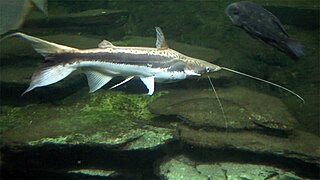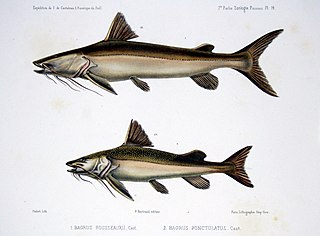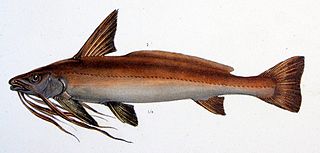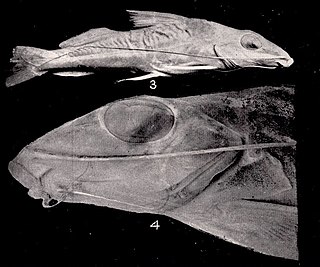
Hypostomus is a genus of catfish in the family Loricariidae. They are native to tropical and subtropical South America. H. plecostomus is the popular freshwater aquarium fish formerly known as Plecostomus plecostomus. The taxonomic structure of the Loricariidae is still being expanded by scientists. Hypostomus is a highly species-rich and widely distributed catfish genus.

Pseudoplatystoma is a genus of several South American catfish species of family Pimelodidae. The species are known by a number of different common names. They typically inhabit major rivers where they prefer the main channels and tend to stay at maximum depth, but some species can also be seen in lakes, flooded forests, and other freshwater habitats. They have robust bodies, and are important food fish. Recently, their population size has been on the drastic decline due to a variety of factors including overfishing and habitat destruction due to the construction of hydroelectric dams.

The Pimelodidae, commonly known as the long-whiskered catfishes, are a family of catfishes.

Sorubim is a small genus of long-whiskered catfish native to tropical South America. A number of characteristics allows the differentiation of each species in the genus. Sorubim species are important food fish in South America and are highly significant to fisheries of some areas; however, harvests of these fish are not identified as much as other, more popular food fishes such as Colossoma, Arapaima, and Brachyplatystoma. Some species of this family are popular aquarium fish.

Brachyplatystoma is a genus of catfish from the family Pimelodidae. As the occasionally used common name goliath catfishes indicates, this genus includes some of the largest species of catfish, including the piraíba, B. filamentosum, which reaches up to the region of 3.6 metres (12 ft) in length. Brachyplatystoma are found in the Amazon and Orinoco basins, and other tropical freshwater and brackish habitats in South America. Some species are migratory. These fish are important as food fish and, to some extent, aquarium fish.
Scoloplax is the only genus in the catfish family Scoloplacidae, the spiny dwarf catfishes.
Exallodontus aguanai is a catfish species of the monotypic genus Exallodontus of the family Pimelodidae. This genus and species was described in 1991. This species reaches 20 centimetres (7.9 in) SL. This species is native to the Amazon and Orinoco River basins of Brazil, Colombia, Peru and Venezuela. Exallodontus is classified under the "Calophysus-Pimelodus clade". Within this clade, it is considered a part of the "Pimelodus-group" of Pimelodids, which also includes Pimelodus, Duopalatinus, Cheirocerus, Iheringichthys, Bergiaria, BagropsisParapimelodus, Platysilurus, Platystomatichthys, and Propimelodus.

Platysilurus is a genus of long-whiskered catfishes native to South America.
Iheringichthys labrosus is a species of long-whiskered catfish native to the Paraná River basin and Uruguay River basin in Argentina, Brazil, Paraguay and Uruguay. This species grows to a length of 29.7 centimetres (11.7 in) TL.

Pinirampus pirinampu is a species of catfish of the family Pimelodidae. P. pirinampu is also known as the flatwhiskered catfish.

Pimelodus is a genus of fish in the family Pimelodidae native to Central and South America.
Hypophthalmus is a genus of long-whiskered catfishes native to freshwater in tropical and subtropical South America.
Hisonotus is a genus of armored catfishes native to South America. Species of Hisonotus and Curculionichthys are the only representatives of the subfamily Otothyrinae having serrae on the posterior edge of the pectoral fin spine. These species are small fishes, generally found in small fast flowing streams, where they grasp to the branches and leaves of aquatic or subaquatic plants. The species of this genus mostly occur in Atlantic coastal streams of southern Brazil and the Paraguay-Paraná system of southern South America. They are also distributed in the Río de La Plata basin and coastal rivers of southeastern Brazil.
Hypostomus cochliodon is a species of armored catfish native to the Paraguay and middle Paraná River basins in northern Argentina, southern Brazil and Paraguay. Initially it did not occur in the upper Paraná basin above the Guaíra Falls, but these disappeared after the construction of the Itaipu Dam, allowing this species to spread. It grows to a standard length of 23 cm (9.1 in).
Loricariichthys rostratus is a species of catfish in the family Loricariidae. It is native to South America, where it occurs in the Paraná River basin in Argentina, Brazil, and Paraguay, with its type locality being designated as the Itaipu Dam's reservoir. The species reaches 27.5 cm in standard length and is believed to be a facultative air-breather.
The Highwaterman catfish, is a species of pelagic potamodromous catfish of the family Pimelodidae that is native to Guyana, Suriname, Venezuela, northern Brazil and Gulf of Paria.
Hypophthalmus oremaculatus, is a species of demersal catfish of the family Pimelodidae that is native to Paraná River basin of Argentina and Brazil.

Iheringichthys megalops, is a species of demersal catfish of the family Pimelodidae that is endemic to the Paraná River basin in Paraguay.
Iheringichthys syi, is a species of demersal catfish of the family Pimelodidae that is native to Upper Rio Paraná in Brazil.
Rhinolekos britskii is a species of catfish in the family Loricariidae. It is native to South America, where it occurs in the Paranaíba River basin in the upper Paraná River system in Brazil. The species reaches 4 cm in standard length. Its specific name, britskii, honors Heraldo A. Britski of the University of São Paulo for his contributions to the ichthyology of the Neotropical realm.









